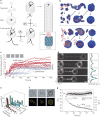Physics of viral dynamics
- PMID: 33728406
- PMCID: PMC7802615
- DOI: 10.1038/s42254-020-00267-1
Physics of viral dynamics
Abstract
Viral capsids are often regarded as inert structural units, but in actuality they display fascinating dynamics during different stages of their life cycle. With the advent of single-particle approaches and high-resolution techniques, it is now possible to scrutinize viral dynamics during and after their assembly and during the subsequent development pathway into infectious viruses. In this Review, the focus is on the dynamical properties of viruses, the different physical virology techniques that are being used to study them, and the physical concepts that have been developed to describe viral dynamics.
Keywords: Biological physics; Nanoscale biophysics; Self-assembly; Supramolecular assembly; Virology.
© Springer Nature Limited 2021.
Conflict of interest statement
Competing interestsG.J.L.W. declares financial interest in fluorescence optical tweezers and acoustic force spectroscopy approaches which are patented and licensed to LUMICKS B.V.
Figures




References
-
- Roos WH, Bruinsma R, Wuite GJL. Physical virology. Nat. Phys. 2010;6:733–743. doi: 10.1038/nphys1797. - DOI
Publication types
LinkOut - more resources
Full Text Sources
Other Literature Sources
